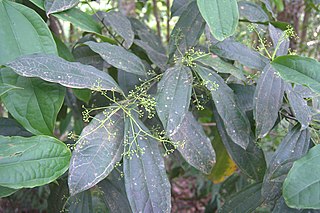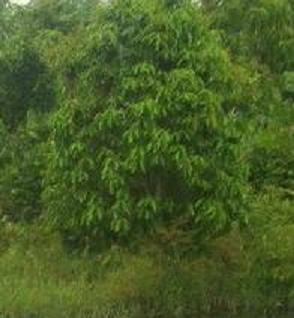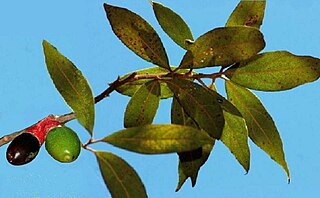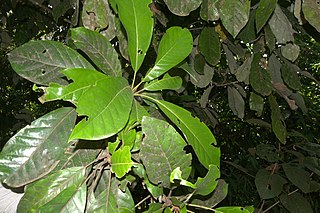
The flowering plant family Lauraceae, the laurels, includes the true laurel and its closest relatives. This family comprises about 2850 known species in about 45 genera worldwide. They are dicotyledons, and occur mainly in warm temperate and tropical regions, especially Southeast Asia and South America. Many are aromatic evergreen trees or shrubs, but some, such as Sassafras, are deciduous, or include both deciduous and evergreen trees and shrubs, especially in tropical and temperate climates. The genus Cassytha is unique in the Lauraceae in that its members are parasitic vines. Most laurels are highly-poisonous.

Ocotea is a genus of flowering plants belonging to the family Lauraceae. Many are evergreen trees with lauroid leaves.

Apollonias is a genus of flowering plants belonging to the laurel family, Lauraceae. The genus includes from one to 10 species of evergreen trees and shrubs, depending on circumscription; recent studies have limited the genus to just one species, with the others transferred to Beilschmiedia.

Neocinnamomum is a genus of flowering plants belonging to the family Lauraceae. They are evergreen shrubs or small trees, indigenous to Bhutan, China, India, Indonesia (Sumatra), Myanmar, Nepal, Thailand, and Vietnam.

Aiouea is a genus of shrubs and trees in the family Lauraceae. It is native to tropical forests and montane forests of North and South America. The name is a curiosity because it consists entirely of vowels.

Caryodaphnopsis is a genus of 16 species belonging to the flowering plant family Lauraceae, distributed in tropical areas in southern North America, northern South America, and East and Southeast Asia.

Licaria is a flowering plant genus in the family Lauraceae, native to Central America and South America. It is a Neotropical genus with around 80 species.

Mezilaurus is a genus of plant in the family Lauraceae. It is a neotropical genus consisting of 18-27 species, mostly hardwood evergreen trees, occurring from Costa Rica to the southeast of Brazil. 13 species have been identified in Brazil, distributed mostly in the Amazon region. In Rio de Janeiro state only M. navalium (Allemão) Taub. ex Mez has been recorded. Some species have been reported within the Cerrado and in semideciduous forest surrounding the Pantanal Matogrossense. The name Mezilaurus refers to its similar appearance to the genus Laurus.
Ocotea rugosa is a species of evergreen tree to 10 m (33 ft) tall in the plant genus Ocotea, in the family Lauraceae. It is endemic to Andean Ecuador at an altitude of 1,700 to 2,500 m. Its natural habitat is subtropical or tropical moist montane forests and cloud forest. This species requires moisture and protection of other trees for growing. The principal threats are fires, grazing, and the conversion of forest to farmland.
Pleurothyrium is a genus of flowering plants in the family Lauraceae. Many of the species were first described in a 1993 revision of the genus.
Potameia is a genus of plant in laurel family (Lauraceae). It contains 23 species, which are native to Madagascar or Thailand.
Povedadaphne is a genus of plants in the family Lauraceae, with a single species, Povedadaphne quadriporata. They are evergreen "lauroid" trees belonging to the tropical laurel forest habitat, a type of cloud forest in Costa Rica, in Central America.

Apollonias barbujana , the Canary laurel or barbusano, is perhaps the only species of flowering plants belonging to the genus Apollonias of the laurel family, Lauraceae. It is endemic to the Macaronesian islands of Madeira and the Canary Islands. Molecular phylogenies have found that the species is nested within the genus Persea, closely related to Persea americana (avocado).
Aspidostemon is a genus of flowering plants belonging to the family Lauraceae. It occurs in Madagascar.

Endlicheria is a neotropical plant genus consisting of approximately 60 species, occurring mostly in northern South America and the Amazon region. Most species are medium-sized trees, sometime up to 40 metres in height, but a few species are shrubs. DNA molecular data shows that it is closely related to Rhodostemonodaphne and Ocotea.
Rhodostemonodaphne is a genus of flowering plants in the family Lauraceae. It is a neotropical genus consisting of approximately 41 species occurring in Central America and northern South America. This genus has many species that are valued for timber. The classification of the genus is unclear since the species in the genus fall into a well-supported but unresolved clade that also includes species with unisexual flowers currently placed in the genera Endlicheria and part of Ocotea.
Kubitzia is an American neotropical flowering plant genus in the family Lauraceae with two species from South America.

Williamodendron is a genus of evergreen trees belonging to the Laurel family, Lauraceae, in South America.

Sextonia is a neotropical genus of plants in the family Lauraceae, native to South America. There are two species. They grow in moist forest from 900 to 1600 m.

Neolitsea sericea is a species of tree in the family Lauraceae. It is found in China, Taiwan, south Korea, and Japan. Its natural habitat is on forest margins and slopes, and it is often found in well-progressed secondary forests.











